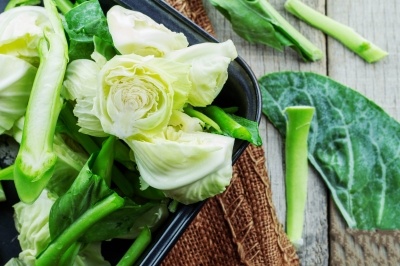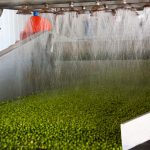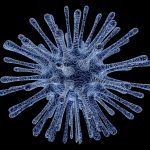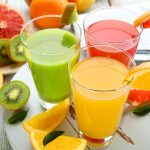
The demand for higher quality foods, especially fruits and vegetables has meant increased interest in preserving as many of the qualities of these foods as possible. Loss of colour is one of the critical quality factors that helps a consumer decide whether a natural foodstuff is fresh or processed. Nowhere is this issue more keenly felt than by processors of fruits and vegetables who want to preserve as much of those fresh attributes as possible. Here we look at some of the work conducted on the degradation of chlorophyll.
One of the most important attributes is the green colour in vegetables. A bright, vibrant green colour is highly desirable for any consumer who perceives a vegetable as fresh or not. Very often after processing green peas or beans for example, we are left with only the unappealing olive-brown pigments. In sensory terms, it is well known that the olive green-brown pigments are distinctly unappealing (Clydesdale and Francis 1969; Clydesdale,1976, 1991; Baardseth et al., 1988; Gnanasekharan et al., 1992).
Chlorophyll and the Green Colour
The green colour is due to the presence of chlorophyll. There are a number of different types of chlorophyll and its associated derivatives. It has the critical role in plant metabolism of securing energy in the form of sunlight to create energy molecules that the plant can metabolise.
If you are interested in reviews about chlorophyll in processing then look no further than the reviews by Schwartz and Lorenzo (1990), and Heaton and Marangoni (1996). Chlorophylls are generally found only in higher plants.
For many years, the retention of chlorophyll has been the standard measure of quality in all green vegetables (Sweeney & Martin, 1961).
Chlorophylls a and b are derivatives of dihydroporphyrin chelated with a centrally located magnesium atom. They occur in an approximately 3:1 ratio in higher plants. Chlorophyll a is the more important molecule of the two and chlorophyll b is seen as having an accessory role in light harvesting.
These chlorophylls contain an isocyclic ring and are made hydrophobic because of the presence of a phytol side chain. That side chain is a C20 monounsaturated isoprenoid esterifying alcohol.
In green cellular tissues subjected to various processing conditions, chlorophyll undergoes distinct types of degradation reactions. The changes in the chlorophyll molecule during heating have been discussed by Jaques et al., (2001). Chlorophyll disappears anyway during fruit ripening and leaf senescence and there is a normal turnover in photosynthetic tissues as part of a programmed reduction in photosynthesis. In the last 20 years, the processes by which this programming takes place have largely been explained and are the basis for food processors attempting to reduce greening and even enhance it irrespective of processing.
According to the older publications reviewed by Gross (1991), the most common degradation of chlorophyll during thermal processing, freezing, and storage of green vegetables is the conversion of chlorophyll to pheophytins with a colour change to olive-brown. Open a can of any processed peas and you can see this colour is quite evident – it does not compare favourably with the colour of freshly frozen peas. In processing, the duration of treatment, temperature, the pH of the medium and concurrent release of acids accelerates colour degradation.
The longer and hotter the processing treatment the worse the damage done to chlorophylls. Take kiwifruit which is a notoriously green fruit. In one study, it was seen that all of the chlorophylls in canned kiwifruit slices were completely degraded after heating at 100°C for 5 min. (Roberston, 1985).
It’s one of the reasons why aseptic processing of vegetables is preferred to canning (Schwartz and Lorenzo, 1991). Microwave processing is also preferred to conventional heat processing (Benlloch-Tinoco et al., 2015).
Even if you freeze fruit and vegetables, there is still some loss of chlorophylls. The chlorophylls in frozen kiwifruit stored at − 18°C were reduced to less than one-third of their initial concentrations within 36 days (Roberston, 1985).
Chlorophyll is more stable at higher pHs (Gold and Weckel, 1959; Sweeney and Martin, 1961; Schwartz and Lorenzo, 1990) -its been known for some time that raising the pH of process water by the addition of sodium bicarbonate for example helps preserve colour when cooking peas and beans on the stove. (Never mind the destruction of vitamin C as it’s the colour that’s important here !) Other alkalising agents used in both blanching and brining solutions include hexametaphosphate, disodium glutamate, sodium hydroxide and magnesium hydroxide (Blair & Ayres, 1943; Gilpin et al., 1959).
Chlorophyll a is known to breakdown more quickly than chlorophyll b during heat processing. The opposite happens during storage of vegetables in flexible containers where chlorophyll b breaks down more rapidly than a. One of the aspects of degradation involves loss of the central magnesium atom. The chlorophyll then breaks down to pheophytin which in turn breaks down to pyropheophytin. The final products appear to be chlorophyllide and pheophorbide.
One of the methods we have commented upon is the use of zinc solutions which can help in the regreening of foods as part of the process operation. Zinc replaces the magnesium atom which helps to preserve the structure of the chlorophyll molecule.
Kinetics
The kinetics of chlorophyll degradation is well researched and generally follows a first-order degradation model. It implies that degradation is dependent only on the chlorophyll concentration as opposed to any other factor. A good example is the study of chlorophyll loss in spinach at low and intermediate water activities at different pHs (Lajollo and Marquez, 1982). Broccoli has also been scrutinized and one study found that pheophytinization as its known follows a first-order loss (Gunawan & Barringer, 2000). In both cases colour loss increased as the pH became more acidic.
Enzyme Activity Causes Loss Of Chlorophyll
One aspect that has not yet been covered is loss of chlorophyll due to enzyme activity. Residual enzymatic activity, due to poor blanching treatment, is also a probable cause of chlorophyll loss. Lipoxygenase which acts on free fatty acids can increase the rate of pheophytisation which is due to an increase in the acid content (Schweimer, 1984).
References Associated With Chlorophyll Degradation (Not All Are Mentioned In the Item Above But Are Worth Checking).
Aparicio-Ruiz, R., Mínguez-Mosquera, M. I., & Gandul-Rojas, B. (2010). Thermal degradation kinetics of chlorophyll pigments in virgin olive oils. 1. Compounds of series a. Journal of agricultural and food chemistry, 58(10), pp. 6200-6208 https://pubs.acs.org/doi/abs/10.1021/jf9043937
Blair, J. S., & Ayres, T. B. (1943). Protection of natural green pigment in the canning of peas. Industrial and Engineering Chemistry, 35, pp. 85–95
Clydesdale, F.M. (1976) Instrumental techniques for color measurement of foods. Food Technol. 30 (10) pp. 52-59.
Clydesdale, F.M. (1991) Color perception and food quality. J. Food Qual. 14(1) pp. 61-74.
Clydesdale FM. Francis FJ. (1969) Colorimetry of foods. 1. Correlation of raw, transformedand reduced data with visual rankings for spinach puree. J. Food Sci. 34(4) pp. 349-352.
Gilpin, G. L., Sweeney, J. P., Chapman, V. J., & Eisen, J. N. (1959). Effect of cooking methods on broccoli. II. Palatability. Journal of the American Dietetic Association, 35, pp. 359
Gold, H.J., Weckel, K.G. (1959) Degradation of chlorophyll to pheophytin during sterilization of canned green peas by heat. Food Technol. 13(5): 281-285
Gonçalves, E. M., Cruz, R. M. S., Abreu, M. T. R. S., Brandão, T. R. S., & Silva, C. L. (2009). Biochemical and colour changes of watercress (Nasturtium officinale R. Br.) during freezing and frozen storage. Journal of Food Engineering, 93(1), pp. 32-39 https://doi.org/10.1016/j.jfoodeng.2008.12.027
Gunawan, M. I., & Barringer, S. A. (2000). Green colour degradation of blanched broccoli (Brassica oleracea) due to acid and microbial growth. Journal of Food Processing and Preservation, 24, pp. 253–263
Gupte, S. M., El‐Bisi, H. M., & Francis, F. J. (1964). Kinetics of thermal degradation of chlorophyll in spinach puree. Journal of Food science, 29(4), pp. 379-382 DOI: 10.1111/j.1365-2621.1964.tb01747.x
http://onlinelibrary.wiley.com/doi/10.1111/j.1365-2621.1964.tb01747.x/full
Heaton, J. W., Lencki, R. W., & Marangoni, A. G. (1996). Kinetic model for chlorophyll degradation in green tissue. Journal of Agricultural and Food Chemistry, 44(2), pp. 399-402.
Heaton, J.W., and Marangoni, A.G. (1996) Chlorophyll degradation in processed foods and senescent plant tissues. Trends in Food Science and Technology, 7, pp. 8–15
Heaton, J. W., Yada, R. Y., & Marangoni, A. G. (1996). Discoloration of coleslaw is caused by chlorophyll degradation. Journal of agricultural and food chemistry, 44(2), pp. 395-398
Jaiswal, A. K., Gupta, S., & Abu-Ghannam, N. (2012). Kinetic evaluation of colour, texture, polyphenols and antioxidant capacity of Irish York cabbage after blanching treatment. Food Chemistry, 131(1), pp. 63-72 https://doi.org/10.1016/j.foodchem.2011.08.032
Jaques, A.G., Bortik, K., Hau, J. and Fay, L.B. (2001) Improved method to track chlorophyll degradation. Journal of Agricultural and Food Chemistry 49 pp. 1117–1122
Koca, N., Karadeniz, F., & Burdurlu, H. S. (2007). Effect of pH on chlorophyll degradation and colour loss in blanched green peas. Food Chemistry, 100(2), pp. 609-615 https://doi.org/10.1016/j.foodchem.2005.09.079
Lajollo, F. M., & Marquez, U. M. L. (1982). Chlorophyll degradation in spinach system at low and intermediate water activities. Journal of Food Science, 47, pp. 1995–1998, 2003.
Lajollo, F. M., Tannenbaum, S. R., & Labuza, T. P. (1971). Reaction at limited water concentrations. Chlorophyll degradation. Journal of Food Science, 36, pp. 850–853
Martins, R. C., & Silva, C. L. M. (2002). Modelling colour and chlorophyll losses of frozen green beans (Phaseolus vulgaris, L.). International Journal of Refrigeration, 25(7), pp. 966-974 https://doi.org/10.1016/S0140-7007(01)00050-0
Paciulli, M., Palermo, M., Chiavaro, E., & Pellegrini, N. (2018). Chlorophylls and Colour Changes in Cooked Vegetables. Fruit and Vegetable Phytochemicals: Chemistry and Human Health, 2nd Edition, pp. 703-719 DOI: 10.1002/9781119158042.ch31 http://onlinelibrary.wiley.com/doi/10.1002/9781119158042.ch31/summary
Robertson, G. L. (1985). Changes in the chlorophyll and pheophytin concentrations of kiwifruit during processing and storage. Food Chemistry, 17(1), pp. 25-32. https://doi.org/10.1016/0308-8146(85)90089-5
Rudra, S. G., Sarkar, B. C., & Shivhare, U. S. (2008). Thermal degradation kinetics of chlorophyll in pureed coriander leaves. Food and Bioprocess Technology, 1(1), pp. 91-99 https://link.springer.com/article/10.1007/s11947-007-0016-z
Schmalko, M. E., & Alzamora, S. M. (2001). Color, chlorophyll, caffeine, and water content variation during yerba mate processing. Drying Technology, 19(3-4), pp. 599-610
Schwartz, S. J., & Elbe, J. H. (1983). Kinetics of chlorophyll degradation to pyropheophytin in vegetables. Journal of Food Science, 48(4), pp. 1303-1306 DOI: 10.1111/j.1365-2621.1983.tb09216.x http://onlinelibrary.wiley.com/doi/10.1111/j.1365-2621.1983.tb09216.x/full
Schwartz, S.J. & Lorenzo, T.V. (1990) Chlorophylls in foods. Critical Reviews in Food Science and Nutrition, 29, pp. 1–17 https://doi.org/10.1080/10408399009527511
Schwartz, S. J., & Lorenzo, T. V. (1991). Chlorophyll stability during continuous aseptic processing and storage. Journal of Food Science, 56(4), pp. 1059-1062 DOI: 10.1111/j.1365-2621.1991.tb14641.x
http://onlinelibrary.wiley.com/doi/10.1111/j.1365-2621.1991.tb14641.x/full
Schweimer, S. (1984) Source book of food Enzymology. Westport, CT: AVI Publishing.
Sweeney, J.P., Martin, M.E. (1961) Stability of chlorophyll in vegetables as affected by pH. Food Technol. 15(5) pp. 263-266
Van Loey, A., Ooms, V., Weemaes, C., Van den Broeck, I., Ludikhuyze, L., Indrawati,, … & Hendrickx, M. (1998). Thermal and Pressure− Temperature Degradation of Chlorophyll in Broccoli (Brassica oleracea L. italica) Juice: A Kinetic Study. Journal of Agricultural and Food Chemistry, 46(12), pp. 5289-5294. DOI: 10.1021/jf980505x https://pubs.acs.org/doi/abs/10.1021/jf980505x
Weemaes, C. A., Ooms, V., Van Loey, A. M., & Hendrickx, M. E. (1999). Kinetics of chlorophyll degradation and color loss in heated broccoli juice. Journal of Agricultural and Food Chemistry, 47(6), pp. 2404-2409
Zhang, L., Li, S., Liu, X., Wang, L., & Sun, X. (2012). Kinetics of chlorophyll degradation and color loss in heated kiwifruit puree. Transactions of the Chinese Society of Agricultural Engineering, 28(6), pp. 289-292
Zheng, Y., Shi, J., Pan, Z., Cheng, Y., Zhang, Y., & Li, N. (2014). Effect of heat treatment, pH, sugar concentration, and metal ion addition on green color retention in homogenized puree of Thompson seedless grape. LWT-Food Science and Technology, 55(2), 595-603 https://doi.org/10.1016/j.lwt.2013.10.011



Leave a Reply